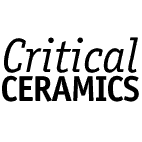


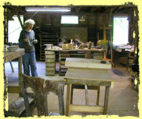
Susan Tunick in the studio
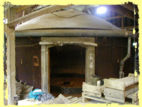
The Beehive Kiln
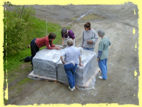
Palettes of Wet Bricks

Anne Currier, Brick Sculptor
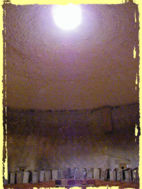
The Beehive Kiln

Twists

Installation View
Watershed Center for the Ceramic Arts
16 - 28 July 2000
Sylvia Netzer
Entry 1 (17 July 2000)
Today is our second day at Watershed; Happily, I have my hands in clay. All the session participants worked together to mix a huge batch of Watershed Earthenware. This involved digging clay out of the hillside, screening it, mixing it with slop and dry ingredients, bagging the clay, and moving it to the upstairs studios. None of us were too eager to attack this project alone, but cooperating made it much more manageable and fun.
This Artist Invites Artists group consists of people that Susan Tunick (New York City) put together; generally everyone has some interest in tiles or architectural ceramics. The artists include Christina Jetten (The Netherlands), Beth Kaminstein (Florida), Linda Huey (New York), Anne Currier (New York), Ann Christenson (Washington), myself (New York City), Donna Pierce (Mexico), Joyce Robbins (New York City), Maila Klemettinen (Finland), and Hannah Nadler (New York City). Jason Green (Massachusetts) and Lisa Deggendorf (Connecticut) are also in attendance. Most of us are in our fifties with a sprinkling of some older and some younger. We all seem to be comfortable with one another, self-accepting and non-competitive. We’re open to try new ideas, materials, and processes.
After mixing the clay, we gathered to discuss ways in which we might interact with one another through our work. Someone suggested that we do Exquisite Corpse (the Surrealist method of producing strange and wonderful drawings by making some marks and passing the image on to the next person). Another, quieter, idea was to make something and have another person create an object in response. Joyce observed that she would be quite content to have a diffident response! I liked both of these ideas. Christina had the notion to make a group installation inside the beehive kiln. Most everyone was excited by this suggestion.
So, we met to discuss in more detail the parameters of the project in the kiln. We looked at the space and talked loosely about ideas. At this point, I decided not to participate because most of my recent work have been installations and abstract - biomorphic or architectronic; I want to spend time working on much more personal themes. I am eager to play with clay and work on a much more personal and intimate scale.
Tomorrow, a pallet of wet bricks is due to arrive. All of the artists are really excited about the possibilities of carving and manipulating bricks. Once the bricks are on site, we will decide how we’d like to use them individually and together. The possibility of using these modules has me revved up!
Today, at the studio, I had the germ of what I think is a good idea for a piece or series of pieces. I made a little sketches of the project and was eager to start in earnest. It feels good to be hot on an idea.
Anne Currier suggested that those who want, could make some of their “signature” elements with the bricks and give them to another artist to assemble in any way he or she saw fit. I liked this idea. With trading these consistent modules, some dynamic pieces may develop.
I started making parts and got into it. There is a chapter about Linda Huey in Richard Zakin’s book, Ceramics: Ways of Creation. I brought it with me because I need to photocopy some pages as part of a grant proposal. What interested me about Linda’s work were her pod pieces which contained fired metal interacting with the shrinking and cracking clay. This nudged me into making highly textured thrown slabs with holes that could be laced together with Nichrome wire for the firing, or perhaps laced together after the firing. I’m thinking about using bubble gum pink gimp or lanyard.
For the first thirty-four hour period, there’s a whole lot of shakin’ going on! I’m very tired and very happy.
Entry 2 (20 July 2000)
Today has been a very exciting day — 2 pallets of wet bricks arrived. We have nearly 1,000 bricks which means that each of us can have about 75 bricks with which to work.
It has been quite interesting to notice how we all are interacting. Most of us only know Susan, so this is an experience of adjusting to a group of strangers with a common connection. More than half of us are college professors who are accustomed to professing to others. I have noted that some of us professors are not collaborating as much as the rest. I’m not sure if there’s anything to this observation or not.
Beth, Donna, Susan, Christina, Hannah, Anne, and Linda continue to work together on a site specific piece for the defunct beehive kiln. The rest of us are involved on the periphery. There is no leader to the group; everyone has an equal voice. Consensus rules. This is fascinating to watch because we’re all outspoken and opinionated women. I think there have been some contentious issues and even a bruised ego or two. None the less, the group continues on the work. They have made ninety twisting forms to hang on the inside edge of the dome. Because eight or nine people were working steadily, the forms were created very quickly. The elements are individual and show the marks of their makers, but related to one another in size and general form. I’m excited to think about how they will look installed in the kiln.
The kiln is quite large. Perhaps it is twenty feet in diameter with round burner ports spaced evenly along the wall. There’s a flue which runs under the floor of the kiln and outside to a chimney. Standing inside, one senses that this kiln is a special space. I think that it is especially significant that we are all women and that the kiln interior is such female space. It is like a womb, round and generative.
I am a bit sorry that I’m not more involved in the group collaboration. However, I am pleased with how my own work is going. I am trying to play and start something that might lead to my next body of work.
Last night, Susan, Anne, and Ann showed slides to the rest of us. It was a study in contrasts. Each had very unique work. Susan’s work is well known to me, as we exchange studio visits as critical and useful activity. However, I was struck by the difference between the image and the actual object.
Anne’s slides showed a lot of change from graduate school to her current work. Anne’s work was familiar to me through books and photographs. I enjoyed obtaining an understanding of more depth as she spoke about the various pieces and themes. I became much more aware of the thinking behind the work.
I’ve seen Ann’s work at NCECA. It was good to learn more about her influences and about the continuing development of her work. In addition, Ann showed spell-binding slides from a recent journey to China.
It’s the morning after slides, now. As I write, Anne and Christine are having breakfast and discussing the aesthetic merits of some of the cups we are all using during our mealtimes. It’s fun to observe their exchange of opinions and ideas. In a few minutes, we’ll all be walking down to the studio. I am really excited about the bricks, even though they are difficult to carve and smell like kerosene.
Entry 3 (23 July 2000)
I was tired and not feeling so hot; I missed much of the discussion and negotiation surrounding the site specific piece in the beehive kiln. Having one less person may have been a good thing as there were many topics to be dissuaded from or persuaded to.
I was delighted to see the subsequent changes to the site. The first was that the group removed the wooden brick shelves that were arranged on their sides like many cilia waving around the inner perimeter of the kiln. They also took down the walls that changed the orientation of the flu grate on the floor of the kiln. When I peered into the kiln, raw bricks formed a four module high wall that echoed the circular shape of the kiln.
Today, part of the group did some work that was more environmental in nature. This new project was a result of Susan and Christine’s early morning walks. They had become interested in two boulders on a rocky outcropping on the farm land next door to Watershed. The idea was to cover one rock in red clay and the other in white clay. Again, decisions were made by consensus. Donna and Hannah collaborated with Susan and Christine. The piece is one thing now; I am eager to see the work tomorrow when the clay has dried and cracked. Hannah says that the group learned that you must actualize the idea in order to make decisions and move forward with the project at hand. Just thinking or theorizing about the site and piece just isn’t enough!
Yesterday, I helped Anne stack a large gas car kiln on the first floor of the Shed. We stacked it tight with wet bricks. In general, I don’t like to stack kilns, but this project turned out to be a lot of fun. Anne truly enjoys the challenge of discovering the most logical means to stack a kiln, the economizing of space. In this case, it is especially tricky because of the thick, wet, bricks. We must have stacked hundreds.
Also, I was impressed by the group and its unloading of the bisqued beehive twists, their cleaning, and glazing. The group just whipped through the hundred or so twists. It is amazing how fast things can go when individuals collaborate.
Joyce and I are going to stack and a fire a lowfire electric kiln tomorrow morning. On tomorrow’s agenda, too, is the glazing of pieces for those of us who played clay telephone (making something and exchanging it with someone who works on it and passes it on again). In the afternoon, we will raku these pieces in a makeshift outdoor kiln.
Entry 4 (26 July 2000)
The past few days have a had a very different rhythm. Several firings are going on at the same time. On Monday, we rakued the “telephone” clay pieces. The firing of the wet bricks has been slow (starting four days ago) and should be out by tomorrow night. Yesterday, Lisa and Beth fired the little soda kiln that sits out in the yard here at the studios.
The collaboration group has staged some guerrilla pieces. They reapplied clay to the farmer’s stones and painted one hot pink and the other dark blue. One of the things that I really noticed from the first pieces was how one really appreciates the subtleties of the natural rocks � the crags and fissures, the varieties of coloration and the lichens on the surface. In contrast, the uniformity of the clay makes the rocks look like crumpled brown paper bags.
The core collaboration group (Tunick, Kamenstein, Nadler, Pierce, and Jetten) made a really magical work in the woods. It is inside a stand of white pines. There, the ground is coved with pine needles and sharply drops off into the pond. The collaborators brought in three or four hundred of the wet bricks and made a carpet that surrounded a small tree. The carpet ends as the earth drops away into water. The bricks are alternated in orientation as to create a pleasing pattern and fringed edge. This piece has quickly taken on the nickname of “Magic Carpet” as it looks like the heavy raw brick paving is preparing to take off at any moment.
Everyone pitched in to help Maila Klemmettin move her work from the second floor of the Shed to the gas kiln building near the house. Her sculpture is nearly five feet by four feet and must weigh at least two hundred pounds. We jumped right in to lend support (physical, emotional, and spiritual). We made wood skids, a foam rubber nest for the piece, and, finally, lowered it and its maker down the industrial elevator. Maila really looked a bit frightened embracing her biomorphic form while sitting inside the winch elevator cage. I was impressed with the great generosity of the group. Once again, there was no leader, a lot of intelligence, and enough muscle. Each of us has come forward when called upon for our strengths and asked for support when we have needed it.
All of us have work in the kilns. We’re excited. Later today, and tomorrow, much work will come out to see the light of day. I especially want to see the bricks that we spent so much time carving.
Beth assisted me stack a bisque kiln. She helped me scrounge the last of the usable posts and shelves. Because of time, I’ve been forced to load really wet work. Plus, the kiln is stacked very tightly. Needless to say, I’m nervous.
I just asked Anne if she would consider participating in something like an Artist Invites Artists session again. Anne considered the question, and replied, “Yes. Sure. Invitations don’t come everyday.” This made me pause and consider for a moment. I thought about my question and said, “Yeah, I would, too. I enjoyed seeing how people interact.” Of course, this isn’t why I came. I came, as we all did, to make work. In particular, my time at Watershed allowed me space to attempt some very different work. I accomplished my goal in great part because this group of artists provided a safe and nurturing environment.

Carved Raw Bricks
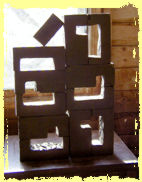
Stacked and Carved Bricks
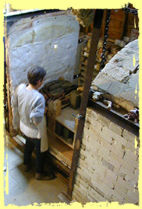
Loading the Car Kiln

Bricks in the Kiln

Maila Klemettinen
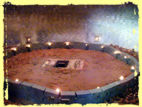
Installation
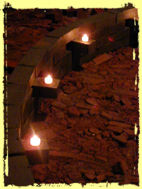
Brick Wall (Detail)
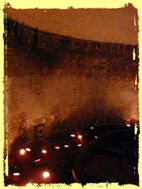
Installation View